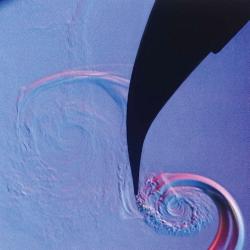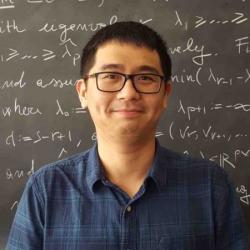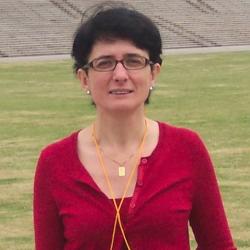
KI-Net Conference: Formation of small scales in nonlinear PDEs
–
4122 CSIC Building
The conference will showcase the latest developments in nonlinear PDEs, with a focus on the dynamic creation of small scales and on mechanisms which either enhance or deplete the strength of the nonlinearities. This workshop will bring together researchers with expertise on a broad range of different models and applications where such small scales play a critical role.
Nonlocal-interaction equations on graphs and their continuum limits
2:00 pm
4122 CSIC Building
Prof. Dejan Slepcev, Department of Mathematical Sciences, Carnegie Mellon University
We consider transport equations on graphs, where mass is distributed over vertices and is transported along the edges. The first part of the talk will deal with the graph analogue of the Wasserstein distance, in the particular case where the notion of density along edges is inspired by the upwind numerical schemes. This natural notion of interpolation however leads to the fact that Wasserstein distance is only a quasi-metric. In the second part of the talk we will interpret the nonlocal-interaction equation equations on graphs as gradient flows with respect to the graph-Wasserstain quasi-metric of the nonlocal-interaction energy. We show that for graphs representing data sampled from a manifold, the solutions of the nonlocal-interaction equations on graphs converge to solutions of an integral equation on the manifold. We also show that the limiting equation is a gradient flow of the nonlocal-interaction energy with respect to a nonlocal analogue of the Wasserstein metric.
Periodic solutions to conservation laws
2:00 pm
4122 CSIC Building
Prof. Constantine Dafermos, Division of Applied Mathematics, Brown University
The lecture will discuss the decay to equilibrium of space-periodic solutions to scalar conservation laws, in several space dimensions, under minimal assumptions on the nonlinearity of the flux. The proof will be self-contained, combining basic topological dynamics with elementary integral geometry.
Recognizing Emergent Behaviors from Short-time Trajectory Data
–
2:00 pm
4122 CSIC Building
Dr. Ming Zhong, Department of Applied Mathematics & Statistics, Johns Hopkins University
The study of emergent behaviors in collective dynamics is a fundamental challenge in a wide variety of disciplines. Classical approaches focus mainly on inducing the emergent behaviors from known interaction laws. We, on the other hand, developed a nonparametric inference approach to learn the interaction laws from trajectory data in [1], and use it to recover the desired dynamics. Having theoretically and computationally examined the convergence properties of our estimators in [1], we employ them to predict the corresponding emergent behaviors. We investigate the prediction capability of our estimators by testing them on a wide range of collective dynamics: opinion dynamics, flocking dynamics, milling dynamics, synchronized oscillator dynamics, and planetary motion in our Solar system.
[1]: F. Lu, M. Zhong, S. Tang, and M. Maggioni, Nonparametric inference of interaction laws in systems of agents from trajectory data, Proceedings of the National Academy of Sciences, 116 (29), 14424 - 14433, 2019.
Young Researchers Workshop: Ki-Net 2012-2019
–
4122 CSIC Building
Participants are invited to present recent developments in kinetic theories -- from particle, network, and agent-based models through kinetic descriptions to macroscopic systems which arise in physical, social, and biological contexts.
Spectral Problems in Inverse Scattering for Inhomogeneous Media
–
2:00 pm
4122 CSIC Building
Prof. Fioralba Cakoni, Department of Mathematics, Rutgers University
The inverse scattering problem for inhomogeneous media amounts to inverting a locally compact nonlinear operator, thus presenting difficulties in arriving at a solution. Initial efforts to deal with the nonlinear and ill-posed nature of the inverse scattering problem focused on the use of nonlinear optimization methods. Although efficient in many situations, their use suffers from the need for strong a priori information in order to implement such an approach. In addition, recent advances in material science and nanostructure fabrications have introduced new exotic materials for which full reconstruction of the constitutive parameters from scattering data is challenging or even impossible. In order to circumvent these difficulties, a recent trend in inverse scattering theory has focused on the development of new methods, in which the amount of a priori information needed is drastically reduced but at the expense of obtaining only limited information of the scatterers. Such methods come under the general title of qualitative approach in inverse scattering theory; they yield mathematically justified and computationally simple reconstruction algorithms by investigating properties of the linear scattering operator to decode non-linear information about the scattering object. In this spirit, a possible approach is to exploit spectral properties of operators associated with scattering phenomena which carry essential information about the media. The identified eigenvalues must satisfy two important properties: 1) can be determined from the scattering operator, and 2) are related to geometrical and physical properties of the media in an understandable way.
In this talk we will discuss some old and new eigenvalue problems arising in scattering theory for inhomogeneous media. We will present a two-fold discussion: on one hand relating the eigenvalues to the measurement operator (to address the first property) and on the other hand viewing them as the spectrum of appropriate (possibly non-self-adjoint) partial differential operators (to address the second property). Numerical examples will be presented to show what kind of information these eigenvalues, and more generally the qualitative approach, yield on the unknown inhomogeneity.
Computational methods for Quantifying Gerrymandering and other computational statistical mechanics problems
–
2:00 pm
4122 CSIC Building
Prof. Jonathan Mattingly, Mathematics Department, Duke University
I will describe some of the interesting problems which have arisen around the problem of understanding Gerrymandering. It is a high sampling dimensional problem. I will talk about some basic MCMC schemes and some extensions to both interesting global moves as well as some other generalizations. I will also take a moment to frame the problem and state some open questions.
Low-Rank Solution Algorithms for Parameter-Dependent Partial Differential Equations
2:00 pm
4122 CSIC Building
Prof. Howard Elman, Department of Computer Science and UMIACS, University of Maryland at College Park
The collection of solutions of discrete parameter-dependent partial
differential equations often takes the form of a low-rank object.
We show that in this scenario, iterative algorithms for computing
these solutions can take advantage of this structure to reduce both
computational effort and memory requirements. Implementation of such
solvers requires that explicit rank-compression computations be done
to truncate the ranks of intermediate quantities that must be computed.
We prove that when truncation strategies are used as part of a multigrid
solver, the resulting algorithms retain "textbook" (grid-independent)
convergence rates and we demonstrate how the truncation criteria affect
convergence behavior. In addition, we show that these techniques can be
used to construct efficient solution algorithms for computing the
eigenvalues of parameter-dependent operators.
This is joint work with Tengfei Su.
Uniqueness of the solution of Vlasov-Maxwell linearized system without a Cauchy datum: the response of a plasma
2:00 pm
4122 CSIC Building
Prof. Olivier Lafitte, Institut Galilée, University Paris 13
Generally, Vlasov equation and Vlasov-Maxwell equations are considered as kinetic equations and are addressed as Cauchy problems. Though, when one listens to the Physics community, they often describe their results as 'the response' of a plasma, stressing on the uniqueness of a solution without prescribing the Cauchy data.
This is only an apparent contradiction, and in this talk (joint work with Omar Maj, NMPP, IPP, Max Planck Institute Garching) describes the obtention of this response for the linearized Vlasov-Maxwell equations around a Maxwellian-type density function using distribution theory.
Regression of functions on low-dimensional manifolds by deep ReLU networks
2:00 pm
4122 CSIC Building
Prof. Wenjing Liao, School of Mathematics, Georgia Institute of Technology
Many data in real-world applications lie in a high-dimensional space but are concentrated on or near a low-dimensional manifold. Our goal is to estimate functions on the manifold from finite samples of data. This talk focuses on an efficient approximation theory of deep ReLU networks for functions supported on low-dimensional manifolds. We construct a ReLU network for such function approximation where the size of the network grows exponentially with respect to the intrinsic dimension of the manifold. When the function is estimated from finite samples, we proved that the mean squared error for the function approximation converges as the training samples increases with a rate depending on the intrinsic dimension of the manifold. These results demonstrate that deep neural networks are adaptive to low-dimensional geometric structures of data. This is a joint work with Minshuo Chen, Haoming Jiang, Tuo Zhao at Georgia Institute of Technology.











